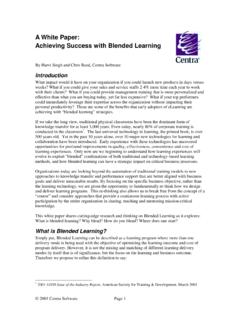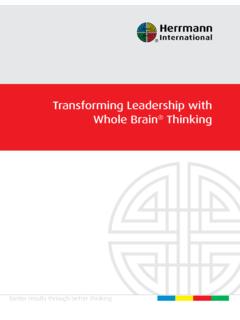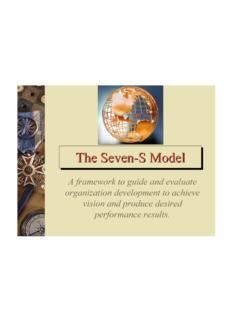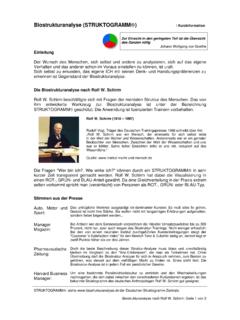Transcription of Learning styles and pedagogy in post-16 learning: …
1 Learning styles and pedagogy in post -16 Learning A systematic and critical reviewLSRC referenceLSRC reference Learning styles and pedagogy in post -16 learningA systematic and critical reviewThis report critically reviews the literature on Learning stylesand examines in detail 13 of the most influential models. The report concludes that it matters fundamentally whichinstrument is chosen. The implications for teaching and Learning in post -16 Learning are seriousand should be of concern to learners, teachers and trainers, managers, researchers and styles and pedagogy in post -16 Learning A systematic and critical reviewLSRC referenceLSRC reference Learning styles and pedagogy in post -16 learningA systematic and critical reviewThis report critically reviews the literature on Learning stylesand examines in detail 13 of the most influential models.
2 The report concludes that it matters fundamentally whichinstrument is chosen. The implications for teaching and Learning in post -16 Learning are seriousand should be of concern to learners, teachers and trainers, managers, researchers and CoffieldInstitute of EducationUniversity of LondonDavid MoseleyUniversity of NewcastleElaine HallUniversity of NewcastleKathryn EcclestoneUniversity of ExeterLSRC referenceLearning styles and pedagogy in post -16 learningA systematic and critical reviewThe Learning and Skills Research Centre is supported by the Learning and Skills Counciland the Department for Education and SkillsThe views expressed in this publication are those of the authors and do not necessarily reflect the views of the Learning and Skills Research Centre or the Learning and Skills Development AgencyPublished by the Learning and Skills Research should be sent to.
3 Sally FaradayResearch ManagerLearning and Skills Development AgencyRegent Arcade House19 25 Argyll StreetLondon W1F 7 LSTel 020 7297 9098 Fax 020 7297 by Helen LundDesigned by sans+baumPrinted by Cromwell Press LtdTrowbridge, Wiltshire1543/06/04/500 ISBN 1 85338 918 8 Learning and Skills Research Centre 2004 All rights reservedSection 1 Section 2 Section 3 Section 4 Section 5 Section 6 Section 7 Section 8 Section 9191337476191119133 AcknowledgementsA systematic review of Learning - styles modelsIntroductionAims of the projectApproaches to the literature reviewIntroduction to Sections 3 7A continuum of Learning stylesFamilies of Learning stylesGenetic and other constitutionally based s Mind styles Model and Style Dunn and Dunn model and instruments of Learning stylesThe cognitive structure s model of cognitive style and his Cognitive styles Analysis (CSA)Stable personality Myers-Briggs Type Indicator (MBTI) s reversal theory of motivational styles , the Motivational Style Profile (MSP) and related assessment s Learning styles Profiler (LSP)
4 Flexibly stable Learning s Learning Style Inventory (LSI) and Mumford s Learning styles Questionnaire (LSQ) Herrmann whole brain model and the Herrmann Brain Dominance Instrument (HBDI) and Hayes Cognitive Style Index (CSI) Learning approaches and s Approaches and Study Skills Inventory for Students (ASSIST)7. 2V e rmunt s framework for classifying Learning styles and his Inventory of Learning styles (ILS)7. 3 Sternberg s theory of thinking styles and his Thinking styles Inventory (TSI)Implications for pedagogyWhat advice for practitioners?The appeal of Learning stylesThe objections to Learning stylesStill no pedagogy in the UKRecommendations and conclusionsPositive recommendationsContinuing problems with the research field of Learning stylesGaps in knowledge and possible future research projectsFinal commentsLSRC referenceContentsReferencesList of Learning - styles instruments and theoriesList of search terms used in the literature reviewGlossary of termsAppendix 1 Appendix 2 Appendix 3147166170171page ?
5 /?LSRC referenceSection ?123456789101112131234567891011121314151 6171819202122232425 LSRC referenceFigures and tables6910101642485563637396124202223263 1363739404548484852565858586071737376777 9 FiguresSelection of literature for reviewCurry s onion model of Learning stylesVermunt s model of Learning styles (1998)Families of Learning stylesGregorc s four-channel Learning -style modelThe two dimensions of the CSAThe four bipolar discontinuous scales of the MBTIP ossible motivational style reversals in four experiential domainsKolb s four Learning stylesThe experiential Learning theory of growth and developmentDimensions of Honey and Mumford s Learning cycleConceptual map of components of effective studying from ASSISTThe 4 MAT systemTablesGregorc s Mind styles Model and Style Delineator (GSD)Variables and factors in the Dunn and Dunn Learning - styles modelElements of Learning style from the Dunn and Dunn modelPercentages of respondents preferring a specific time of dayStudies of the Learning -style preferences of able studentsDunn and Dunn s model and instruments of Learning stylesLearning- styles instruments in the cognitive structure familyKogan s classification of Learning stylesStudies of the interaction of field independence and attainment with learners aged 14+ yearsRiding s Cognitive styles Analysis (CSA)The 16 MBTI personality typesSummary of the 10 most common MBTI typesAuthors report of test retest reliability of the MBTI Form GMyers-Briggs Type Indicator (MBTI)Apter s Motivational Style Profile (MSP)
6 Key characteristics of each styleStrengths and weaknesses of the different preferencesThe extent to which corresponding scales Jackson (LSP) and Honey and Mumford (LSQ) measure the same constructsJackson s Learning styles Profiler (LSP)Kolb s Learning Style Inventory (LSI)Strengths and weaknessesLSQ retest correlations, by Learning styleActivities and preferencesHoney and Mumford s Learning styles Questionnaire (LSQ) Whole brain Learning and design considerations26272829303132333435363738 3940414243448181838587909597103105105107 11011111611611 8135140 Summary of positive and negative loading items on two HBDI factorsItem loadings on the four main HBDI factorsIllustrative occupational group normsHerrmann s Brain Dominance Instrument (HBDI)Items which best characterise analysisand intuitionAllinson and Hayes Cognitive styles Index (CSI)Defining features of approaches to Learning and studyingReliability of ASI sub-scalesEntwistle s Approaches and Study Skills Inventory for Students (ASSIST)Vermunt s Learning styles with illustrations of their componentsAreas and sub-scales of the ILSE xemplar vignettes of Vermunt s four Learning styles using ILS itemsVermunt s Inventory of Learning styles (ILS)Summary of styles of thinkingThinking styles and methods of instructionThinking styles and methods of assessmentSternberg s Thinking styles Inventory (TSI)
7 Effect sizes for different types of intervention13 Learning - styles models matched against minimal criteriaThe project team would like to extend thanks to theauthors of the models reviewed in this report for theircomments and reactions to our work which enabled us to improve the quality of the final also wish to acknowledge the steady and sensitivesupport of John Vorhaus of the Learning and SkillsDevelopment Agency (LSDA) and the administrativeskills of Louise Wilson of the University of Newcastleupon Tyne. Eugene Sadler-Smith read an earlier versionof this repor t and made some useful comments forwhich we are also referenceThe theory and practice of Learning styles has generated great interest and controversy over the past20 years and more. The Learning and Skills ResearchCentre would like to express its appreciation to theauthors of two complementary reports, for the time andeffor t that went into their production and for providing a valuable resource for researchers and practitioners in the Learning and skills reports serve two key purposes: first, theycontribute to what we know about models of learningstyles and to our knowledge of what these offer toteachers and learners.
8 Second, the reports identify an agenda for fur ther research: to evaluate rigorouslykey models in a variety of Learning environments in order to better understand their merits and publish these reports in the spirit of stimulatingdebate and enabling knowledge of Learning styles to be developed for the benefit of practice and complementar y repor t Should we be using learningstyles?explores what research has to say to sections are common to both reports: these draw out the implications for pedagogy and offerrecommendations and conclusions for practitioners,policy-makers and the research would also like to thank the steering committeefor incisive commentary and support throughout the John VorhausResearch ManagerLearning and Skills Development AgencySteering committee members:Professor Charles DesforgesProfessor Noel EntwistleProfessor Phil HodkinsonDr John VorhausLSRC referenceFo rewordLSRC referenceIntroductionHow can we teach students if we do not know how they learn?
9 How can we improve the performance of our employees if we do not know how we ourselveslearn or how to enhance their Learning ? Are the Learning difficulties of so many students/employeesbetter understood as the teaching problems oftutors/workplace training managers? How can wepretend any longer that we are serious about creating a Learning society if we have no satisfactory response to the questions: what model of Learning do we operatewith and how do we use it to improve our practice and that of our students/staff/organisation? These are just some of the issues raised by those researcherswho for the last 40 50 years have been studying thelearning styles of is a strong intuitive appeal in the idea thatteachers and course designers should pay closerattention to students Learning styles by diagnosingthem, by encouraging students to reflect on them and by designing teaching and Learning interventionsaround them.
10 Fur ther evidence for the idea that we have individual Learning styles appears to be offeredwhen teachers notice that students vary enormously in the speed and manner with which they pick up newinformation and ideas, and the confidence with whichthey process and use them. Another impetus to interestin post -16 Learning styles is given by a governmentpolicy that aims to develop the necessary attitudes and skills for lifelong Learning , particularly in relation to Learning to learn . These are widely assumed bypolicy-makers and practitioners to be well delineated,generic and transferable. The logic of lifelong Learning suggests that students will become more motivated to learn by knowing moreabout their own strengths and weaknesses as turn, if teachers can respond to individuals strengthsand weaknesses, then retention and achievement rates in formal programmes are likely to rise and Learning to learn skills may provide a foundation forlifelong Learning .






